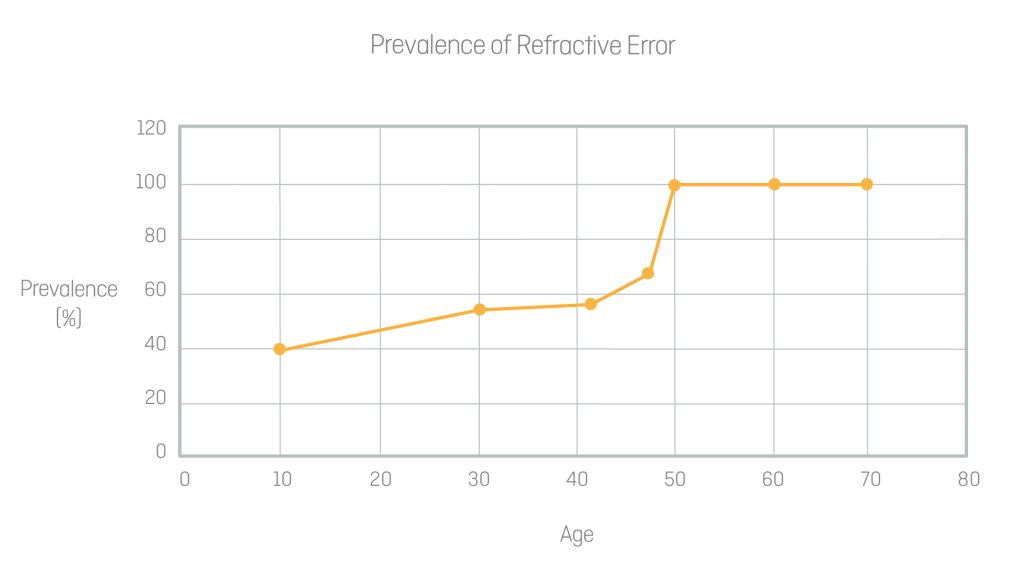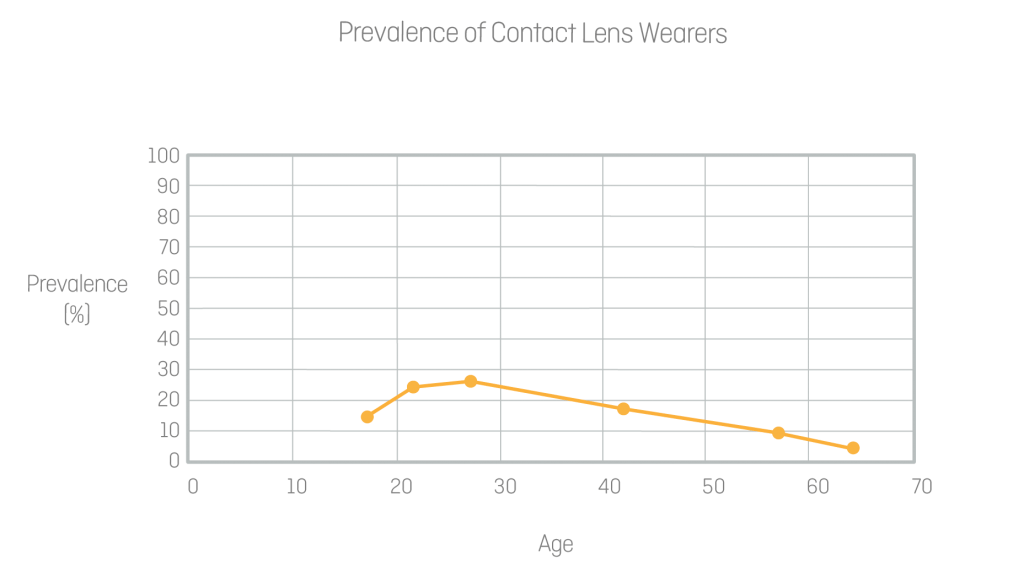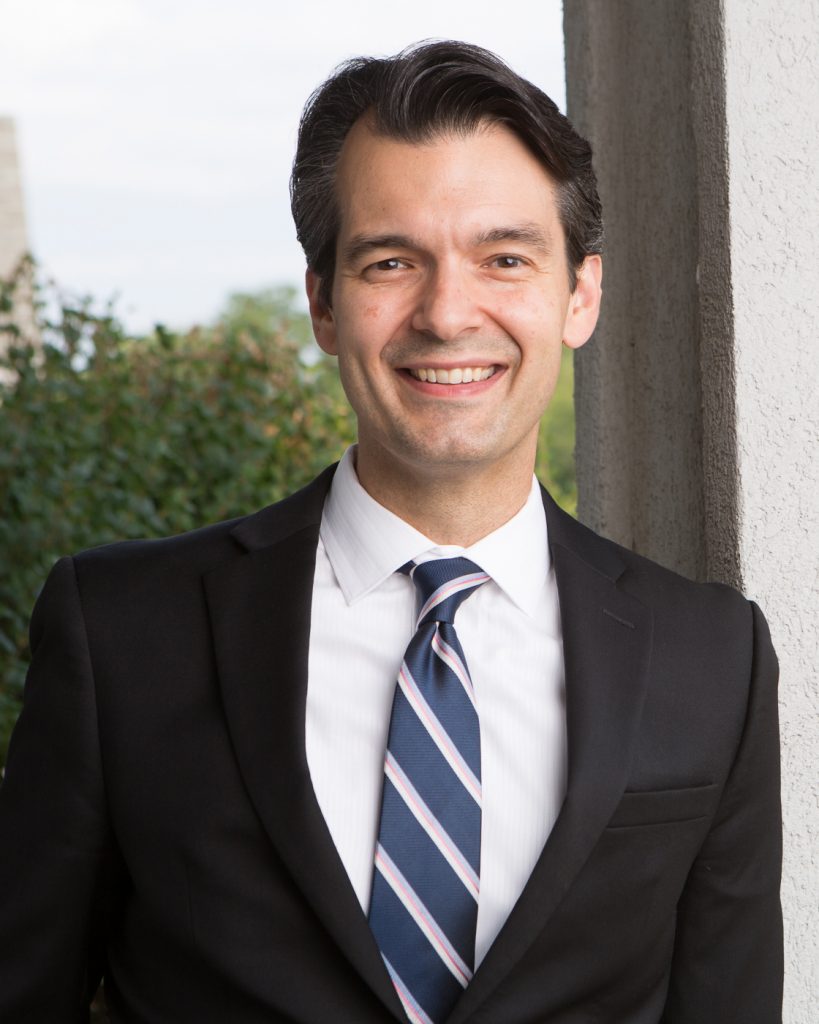The Prevalence of Refractive Error in an Ageing Population
Are We Ignoring or Embracing the Unmet Need?
By Mile Brujic, OD, FAAO
Eye care has evolved at a tremendous rate over the last decade. In addition to providing patients with appropriate refractive correction through glasses and contact lenses, we are now devoting an increasing portion of our time to medically managing our patients. With the vast number of technological advancements our profession has embraced, along with a continuously increasing scope of practice, we are better able to care for our patients that need our help the most.
As recently as fifteen years ago, we had no pharmaceutical options to manage patients with dry eye disease. Often, we attempted to provide as much lubrication as possible to the ocular surface. For those patients who had dry eye and were contact lens wearers, we had opportunities to optimize the contact lens fit characteristics and material selection in attempts to improve a patient’s wearing experience with their lenses. We now have opportunities with new materials, new lens surface properties, new pharmaceuticals, and new in-office treatment regimens to help enhance our patient’s contact lens wearing experience.
Although eye care has evolved tremendously, providing increased opportunities for patient care, we are also at a crossroads in the delivery of our prescription medical devices to our patients. We have seen the introduction of several entities that are attempting to place a wedge in the eye care provider-patient relationship through altering the traditional dynamics of the fitting and prescribing of contact lenses and glasses. Additional outlets to purchase both glasses and contact lenses have overwhelmed patients with options that challenge traditional care models.
A simple Google search of “online contact lenses” yielded 182,000,000 results. In the first two pages of the search results, there were over twenty online options to purchase contact lenses. When performing a similar search for “online glasses”, the results were very similar. Shortly after I performed the two searches, I logged into my email account. Interestingly, advertisements for online entities that retailed contact lenses and glasses were cycling through the right side of my email encouraging me to click on them to purchase contact lenses and glasses at various online retailers.
There seems to be increasing attention to existing contact lens wearers by a number of commercial entities in attempts to destabilize the eye care provider-patient relationship. This is often a patient who wears single vision contact lenses, and commonly these are healthy teenagers and non‐presbyopic adults. As eye care practitioners with healthy contact lens practices, often times we view this as a critical and necessary portion of our eye care practices. But, are there opportunities that are available in places that we may be neglecting?
A Look at the Numbers
At the time that this article was written, the population in the United States was 328,211,622.1 Understanding the population distribution is critical to help understand where a potential unmet need in eye care may be. When we analyze the population, we can essentially divide the population into four categories, and apply generalised characteristics to aid our understanding.
The first category is composed of those that are less than twenty years old. This group, as a whole, is typically relatively healthy. From an eye care perspective, the prevalence of hyperopia tends to decrease while the prevalence of myopia tends to increase as children age.2, 3, 4, 5
The second category of patients are those between 20 to 39 years of age. This category will often have relatively stable prescriptions, although changes can certainly occur.
The third age category are those individuals between the ages of 40 and 69 years of age. This is the population where we tend to see more chronic ocular conditions manifest. This is also the inescapable age category where presbyopia will essentially affect every patient at some point.
The fourth category of patients are those that are 70 years and older. In this patient population, chronic ocular conditions increase in prevalence and the need for cataract surgery increases as well.
When we look for unmet need, it is critical to understand the various age demographics and their need for refractive error correction. As we examine the different age demographics, we realize that there is an increasing prevalence of refractive error with an ageing population.
Although it is difficult to get exact prevalence data for refractive error in each of these age demographics, there is significant data on prevalence of refractive error. For those individuals between the ages of 5 and 17 years of age, the need for refractive correction is 37%.6 The demographic of individuals between the ages of 18 to 39 have been reported to have a need for refractive correction ranging from 47% to 61%.7, 8 Those individuals that are between the ages of 40 to 69 years of age have a prevalence of refractive errors ranging from 63% to 91% depending on the source and the age of the individual.7, 8 During this 30-year time span, the need for refractive correction increases. What is remarkably interesting about this age demographic is that the prevalence data discussed in this age category includes distance refractive error but does not include presbyopic refractive correction. When this is factored into the discussion, virtually 100% of patients will require refractive correction. The highest incidence of presbyopia is between 42 and 44 years of age.9 (Figure 1)

Figure 1: Prevalence of refractive error.
Not surprisingly, the need for refractive correction increases as we age. When we take into account the need for presbyopic correction in the early forties, virtually 100% of this age category require refractive correction. But there seems to be an interesting yet concerning fact when we look at the percentage of patients requiring refractive correction who wear contact lenses. We would expect that as the need for refractive correction increases, the percentage of patients who wear contact lenses would also increase in a proportional manner. But, what actually occurs is exactly the opposite.
When we analyze contact lens wearing habits, we see that 14.5% of adolescents are currently wearing contact lenses. Between the ages of 18 and 24 years, 24.4% of people are wearing contact lenses. Generally, adults 25 years of age and older are wearing contact lenses at a rate of 15.5%. 10, 11 As the adult patient ages, the prevalence of contact lens wear decreases. Between the ages of 25 to 29 years of age, approximately 26% of patients wear contact lenses. By the time a patient is between the ages of 40 to 44 years, 19% of patients are wearing contact lenses. As a whole, only 7% of patients over 50 years old wear contact lenses.12 Between the ages of 55 to 59, the number of contact lens wearers drops to 10%. For those patients 60 years and older, this number dwindles to 4%.7 (Figure 2)

Figure 2: Prevalence of contact lens wearers.
It is very clear that the need for correction of refractive error increases throughout the decades, peaking in the presbyopic years. When the need for presbyopic correction is taken into consideration, virtually 100% of the population will require refractive correction. There will always be exceptions to the rule, such as those individuals who have one eye that is myopic and thus function with monovision. Additionally, patients with small pupils may have a pinhole effect with their vision and require less than expected add power.
What is also remarkable is that as the need for vision correction increases, we see a corresponding decrease in the prevalence of contact lens wearers. Logic would lead us to believe that if there is an increasing need for refractive correction, there would be a corresponding increase in prevalence of contact lens wearers. Surprisingly, we see a sharp decline in prevalence of lens wear. Overlying the need for refractive correction with the prevalence of contact lens wear shows an alarming trend. (Figure 3)

Figure 3: Prevalence of contact lens wearers plotted against prevalence of refractive error. This demonstrates the unmet need and also the opportunity for patients and practitioners.
Part of the reason for this is the fact that presbyopes who are not contact lens wearers may not be offered contact lenses as an option for vision correction. For many patients, if they are not offered contact lenses, they are unaware that they are candidates them. Sometimes these individuals will forego professional care and treat themselves with over the counter reading glasses. For those individuals that do come in for professional care, they are often looking for professional recommendations on appropriate glasses. Without knowledge of contact lens candidacy, patients are being misinformed on their options for appropriate vision correction.
Then, there is a second category of patients that used to wear contact lenses but have discontinued wearing them. When patients that discontinue contact lens wear are asked the reasons for discontinuation, the number one reason is always comfort. But, for those who are over forty who admit to discontinuing lens wear, there is a higher proportion who discontinue lens wear because of vision issues.7
The presbyope certainly has unique visual needs which require not only special attention to detail, but also an appropriate approach to educating them on their vision correction options. There is a need to correct both distance and near vision. There are many options that provide this, but appropriate education and fitting strategies will help set expectations and outcomes.
Understanding the Unmet Need
In the United States, approximately 36% of the population is between the ages of 40 and 69,13 which is approximately 118,000,000 people. There is no other age category that is in greater need for refractive correction and no other category that has a lower percentage of patients wearing contact lenses. Certainly, there will be individuals in this age category that are not interested in contact lenses, but it is incumbent upon us to educate them about the availability of technologies to help correct their needs.
There is a remarkable opportunity to help our presbyopic patients. This unmet need provides a remarkable opportunity for patients to become more functional without their glasses. As such, it provides the proactive eye care provider with a tremendous opportunity to help these patients function more independently of glasses.
Several contact lens designs give eye care practitioners opportunities to help meet the increasing demands for the active presbyope. A variety of soft multifocal lens options are available, including both spherical and toric correction for our patients. Multifocal gas permeable lenses provide distance optics in the center of the lens and near optics in the periphery. This provides not only simultaneous vision design advantages but also additional add in visual axis through translation of the lens. Additionally, there are segmented GP multifocal designs as well. There are also several scleral lens multifocal lens designs that can help presbyopic patients function better.
Understanding the unmet need with presbyopes and contact lens wear is critical to understand in the contemporary contact lens practice. Actively becoming educated on options for correction and sharing this with your patient base will help fill an unmet need. Ultimately this will be good for your patients and good for your practice.
1. https://www.census.gov/popclock/
2. https://www.ncbi.nlm.nih.gov/pmc/articles/PMC5437471/
3. https://iovs.arvojournals.org/article.aspx?articleid=2585947
4. https://www.ncbi.nlm.nih.gov/pmc/articles/PMC2694012/
5. https://iovs.arvojournals.org/article.aspx?articleid=2364963
6. https://nationalcenter.preventblindness.org/
7. https://www.clspectrum.com/supplements/2010/march‐2010/presbyopiaopportunity/ 40‐is‐the‐new‐20‐20‐x2014;‐presbyopia‐equals‐opp
8. https://www.thevisioncouncil.org/sites/default/files/Q415‐Topline‐Overview‐
9. https://www.aoa.org/documents/optometrists/CPG‐17.pdf 10. https://www.aoa.org/patients‐and‐public/caring‐for‐your‐vision/contact‐lenses/factsand‐stats
11. https://www.cdc.gov/mmwr/volumes/66/wr/mm6632a2.htm 12. https://www.clspectrum.com/issues/2009/november‐2009/overcoming‐thepresbyopia‐problem
13. https://censusreporter.org/profiles/01000us‐united‐states/
Thank you to Mile Brujic, O.D. for contributing to Global Insight.

Mile Brujic, OD, FAAO is a 2002 graduate of the New England College of Optometry. He is a partner of Premier Vision Group, a successful three location optometric practice in Northwest Ohio. Dr. Brujic practices full scope optometry with an emphasis on ocular disease management of the anterior segment and specialty contact lenses. He is active at all levels of organized optometry. Dr. Brujic is on the editorial board for a number of optometric publications. He has published over 350 articles and has given over 1600 lectures, both nationally and internationally on contemporary topics in eye care.
Read more by Mile Brujic:
